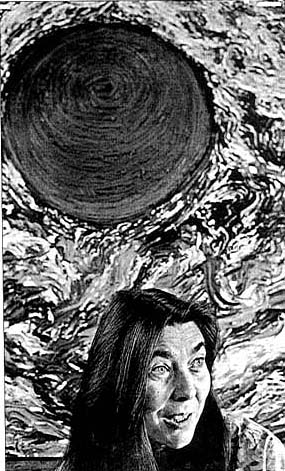 |
Obituaries |
 |
THE TIMES MONDAY 9 JULY 2001 |
Obituaries 15 |
MARY BARNES
She was born in Portsmouth, the eldest child of "abnormally nice" parents whom she later blamed for her depression. Each of the parents confided in their daughter about the shortcomings of the other. Mary felt she had ingested their lack of communication and was convinced that her mother had never forgiven the three-day labour of giving birth to her.

Rescue came in 1956 in the form of the psychiatrist R.D. Laing and Kingsley Hall in the East End of London (once Gandhi's London base), which Laing ran as a household where his patient-centred, non-institutional and non-interventionist approach to mental disturbance could be practised. Here, in her own little room, Mary was encouraged to make a regressive descent into the infantile state, from which she could again grow up into sanity. She no longer spoke, but squealed; she was fed from a bottle, and slept naked in a wooden chest.
One day her psychotherapist, Dr Joseph Berke, Laing's American disciple and the butt of Mary Barnes's most extreme demands and belabourings, gave her a round toffee tin of crayons, and a pile of paper and told her to scribble. From the crayon scribbles she developed her finger-painting, channelling her energy into producing wild, primitive canvases, featuring crosses and other religious images, flaming suns, mountains, curdled clouds. Where, before she had kicked and screamed and lashed out, sometimes covering herself in excrement, she now covered the walls with paintings.
By the time she published her book, Mary Barnes: Two Accounts of a Journey Through Madness (with Joe Berke), she was having her third exhibition of paintings and writing short mythical stories to accompany them. Barefoot at her book launch, she wore a vibrantly coloured skirt made up of patchwork pieces snipped from the clothes of fellow residents in Kingsley Hall. She relished the sudden fame, and the appreciation of critics and journalists, speaking about her harrowing experiences in an enthusiastic little-girl voice, describing how her life had seemed a prison until she had arrived at Kingsley Hall, where in the security of a tolerant community she was allowed to live absorbed in herself 24 hours a day.
It had been a demanding and energy consuming process for her doctors and carers. But given her manifest joie de vivre and literary success, it was not surprising that many other mentally unstable and psychotically disturbed people were soon begging to undergo the same process.
With Dr Berke, Barnes founded the Arbours Housing Association, the charity which sets up households for the mentally disturbed as an alternative to mental hospitals.
In 1981 she published Something Sacred, a collection of her poetry and reflections on the nature of mental illness, a volume dedicated to "Joe". Meanwhile, she had moved to Chagford in Devon, then to Glasgow, trying to set up therapeutic centres, living on her nursing pension and on occasional proceeds from her paintings. But when she arrived at Tomintoul, in Banffshire, the highest village in the Highlands, she decided to spend the rest of her life there.
She continued to travel and lecture despite being wheelchair bound with rheumatoid arthritis for her last 13 years. She used her feet to propel herself backwards, even in deep snow. Seven years ago, she attended Dr Berke's wedding, in Jerusalem, where she had been in 1946 with the British Arm. With her beatific smile and pernially youthful outlook she always rely on the kindness, strangers and on being centre of attention in any setting. In 1975 the playwright D; Edgar adapted her book a powerful play, Mary Barnes suggestion had come from actress Patti Love, who played title role at the Royal Court in I with Simon Callow as Dr & The play was revived in 199' Radio 4, again starring Love Callow, and it continues to fl interest in her story.
Painting madness from the inside looking out. Mary Barnes pictured with her work in 1969, Mary Barnes, artist and writer, was born on February 1923. She died on June 29, 2001 aged 78.